陕西科技大学:《包装技术基础 Fundamentals of Packaging Technology》课程PPT教学课件(英文版)Lesson 14 Test Method for Product Fragility 第14课 产品脆值试验方法
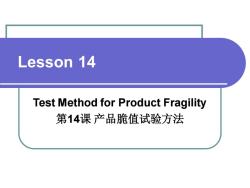
Lesson 14 Test Method for Product Fragility 第14课 产品脆值试验方法
Lesson 14 Test Method for Product Fragility 第14课 产品脆值试验方法
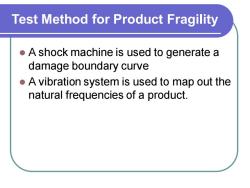
Test Method for Product Fragility ⚫ A shock machine is used to generate a damage boundary curve ⚫ A vibration system is used to map out the natural frequencies of a product
Test Method for Product Fragility ⚫ A shock machine is used to generate a damage boundary curve ⚫ A vibration system is used to map out the natural frequencies of a product

Shock: Damage Boundary Shock damage to products results from excessive internal stress induced by inertia forces - Since F=ma, shock fragility is characterized by the maximum tolerable acceleration level, i. e, how many g’s the item can withstand. - Why damaged? - How to reduce g’s ? The packaging material changes the shock pulse delivered to the product so that the maximum acceleration is greatly reduced (and the pulse duration is many times longer). - The package designer’s goal: To be sure that the g-level transmitted to the item by the cushion is less that the g-level which will cause the item to fail
Shock: Damage Boundary Shock damage to products results from excessive internal stress induced by inertia forces - Since F=ma, shock fragility is characterized by the maximum tolerable acceleration level, i. e, how many g’s the item can withstand. - Why damaged? - How to reduce g’s ? The packaging material changes the shock pulse delivered to the product so that the maximum acceleration is greatly reduced (and the pulse duration is many times longer). - The package designer’s goal: To be sure that the g-level transmitted to the item by the cushion is less that the g-level which will cause the item to fail
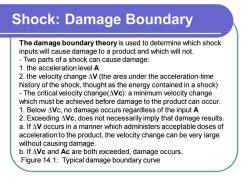
Shock: Damage Boundary The damage boundary theory is used to determine which shock inputs will cause damage to a product and which will not. - Two parts of a shock can cause damage: 1. the acceleration level A 2. the velocity change ∆V (the area under the acceleration-time history of the shock, thought as the energy contained in a shock) - The critical velocity change(∆Vc): a minimum velocity change which must be achieved before damage to the product can occur. 1. Below ∆Vc, no damage occurs regardless of the input A 2. Exceeding ∆Vc, does not necessarily imply that damage results. a. If ∆V occurs in a manner which administers acceptable doses of acceleration to the product, the velocity change can be very large without causing damage. b. If ∆Vc and Ac are both exceeded, damage occurs. Figure 14.1: Typical damage boundary curve
Shock: Damage Boundary The damage boundary theory is used to determine which shock inputs will cause damage to a product and which will not. - Two parts of a shock can cause damage: 1. the acceleration level A 2. the velocity change ∆V (the area under the acceleration-time history of the shock, thought as the energy contained in a shock) - The critical velocity change(∆Vc): a minimum velocity change which must be achieved before damage to the product can occur. 1. Below ∆Vc, no damage occurs regardless of the input A 2. Exceeding ∆Vc, does not necessarily imply that damage results. a. If ∆V occurs in a manner which administers acceptable doses of acceleration to the product, the velocity change can be very large without causing damage. b. If ∆Vc and Ac are both exceeded, damage occurs. Figure 14.1: Typical damage boundary curve

Shock: Damage Boundary Implications of Fig.14.1: a. if the input ∆Vthe product’s ∆Vc, However, the only way to avoid damage is to limit the input A < the product’s Ac. This is usually one of the functions that a cushioned package performs: it translates the high acceleration events experienced on the outside of the container to lower acceleration events experienced inside at the unit
Shock: Damage Boundary Implications of Fig.14.1: a. if the input ∆Vthe product’s ∆Vc, However, the only way to avoid damage is to limit the input A < the product’s Ac. This is usually one of the functions that a cushioned package performs: it translates the high acceleration events experienced on the outside of the container to lower acceleration events experienced inside at the unit

Shock: Damage Boundary Figure 14.1 Typical damage boundary curve
Shock: Damage Boundary Figure 14.1 Typical damage boundary curve
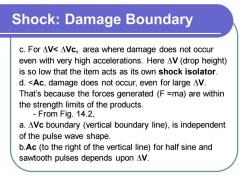
Shock: Damage Boundary c. For ∆V< ∆Vc, area where damage does not occur even with very high accelerations. Here ∆V (drop height) is so low that the item acts as its own shock isolator. d. <Ac, damage does not occur, even for large ∆V. That’s because the forces generated (F =ma) are within the strength limits of the products. - From Fig. 14.2, a. ∆Vc boundary (vertical boundary line), is independent of the pulse wave shape. b.Ac (to the right of the vertical line) for half sine and sawtooth pulses depends upon ∆V
Shock: Damage Boundary c. For ∆V< ∆Vc, area where damage does not occur even with very high accelerations. Here ∆V (drop height) is so low that the item acts as its own shock isolator. d. <Ac, damage does not occur, even for large ∆V. That’s because the forces generated (F =ma) are within the strength limits of the products. - From Fig. 14.2, a. ∆Vc boundary (vertical boundary line), is independent of the pulse wave shape. b.Ac (to the right of the vertical line) for half sine and sawtooth pulses depends upon ∆V
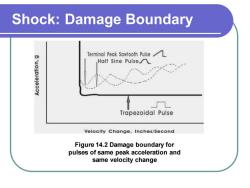
Shock: Damage Boundary Figure 14.2 Damage boundary for pulses of same peak acceleration and same velocity change
Shock: Damage Boundary Figure 14.2 Damage boundary for pulses of same peak acceleration and same velocity change

Shock: Damage Boundary c. The damage boundary generated with use of a trapezoidal pulse encloses the damage boundaries of all the other waveforms. - Fragility testing is the process used to establish damage boundaries of products. a. It is usually conducted on a shock testing machine. The procedure has been standardized (ASTM D3332, Mechanical-Shock Fragility of Products, Using Shock Machines). b. Procedure: the item to be tested is fastened to the top of a shock machine table and the table is subjected to controlled velocity changes and shock pulses. The shock table is raised to a preset drop height. It is then released, free falls and impacts against the base of the machine; it rebounds from the base and is arrested by a braking system so that only one impact occurs
Shock: Damage Boundary c. The damage boundary generated with use of a trapezoidal pulse encloses the damage boundaries of all the other waveforms. - Fragility testing is the process used to establish damage boundaries of products. a. It is usually conducted on a shock testing machine. The procedure has been standardized (ASTM D3332, Mechanical-Shock Fragility of Products, Using Shock Machines). b. Procedure: the item to be tested is fastened to the top of a shock machine table and the table is subjected to controlled velocity changes and shock pulses. The shock table is raised to a preset drop height. It is then released, free falls and impacts against the base of the machine; it rebounds from the base and is arrested by a braking system so that only one impact occurs

Shock: Damage Boundary c. For trapezoidal pulses, the programmer is a constant force pneumatic cylinder. The g-level of the trapezoidal pulse is controlled simply by adjusting the compressed gas pressure in the cylinder. The ∆V is controlled by adjusting drop height. A Shock Testing Machine (1)
Shock: Damage Boundary c. For trapezoidal pulses, the programmer is a constant force pneumatic cylinder. The g-level of the trapezoidal pulse is controlled simply by adjusting the compressed gas pressure in the cylinder. The ∆V is controlled by adjusting drop height. A Shock Testing Machine (1)
按次数下载不扣除下载券;
注册用户24小时内重复下载只扣除一次;
顺序:VIP每日次数-->可用次数-->下载券;
- 陕西科技大学:《包装技术基础 Fundamentals of Packaging Technology》课程PPT教学课件(英文版)Lesson 13 Mechanical Shock Theory 第13课 机械冲击理论.ppt
- 陕西科技大学:《包装技术基础 Fundamentals of Packaging Technology》课程PPT教学课件(英文版)Lesson 12 Shock, Vi ation, and Compression 第12课 冲击、振动和受压.ppt
- 陕西科技大学:《包装技术基础 Fundamentals of Packaging Technology》课程PPT教学课件(英文版)Lesson 11 Package Printing 第11课 包装印刷.ppt
- 陕西科技大学:《包装技术基础 Fundamentals of Packaging Technology》课程PPT教学课件(英文版)Lesson 10 Graphic Design in Packaging 第10课 包装中的平面设计.ppt
- 石河子大学:《工业工程基础》课程PPT教学课件(农机专业,2012)第8章 生产率.ppt
- 石河子大学:《工业工程基础》课程PPT教学课件(农机专业,2012)第4章 工作研究概述.ppt
- 石河子大学:《工业工程基础》课程PPT教学课件(农机专业,2012)现场管理.ppt
- 石河子大学:《工业工程基础》课程PPT教学课件(农机专业,2012)第一章 工业工程概述(1.1)工业工程的发展和作用(主讲人:张慧明).ppt
- 石河子大学:《工业工程基础》课程PPT教学课件(农机专业,2012)第一章 工业工程概述(1.2)工业工程定义和内容.ppt
- 石河子大学:《工业工程基础》课程PPT教学课件(农机专业,2012)预定时间标准及模特法.ppt
- 石河子大学:《工业工程基础》课程PPT教学课件(农机专业,2012)操作分析.ppt
- 石河子大学:《工业工程基础》课程PPT教学课件(农机专业,2012)程序分析.ppt
- 石河子大学:《工业工程基础》课程PPT教学课件(机制专业,2011)第四章 工作研究概述.ppt
- 石河子大学:《工业工程基础》课程PPT教学课件(机制专业,2011)第六章 时间研究与工作抽样.ppt
- 石河子大学:《工业工程基础》课程PPT教学课件(机制专业,2011)第五章 方法研究的分析技术.ppt
- 石河子大学:《工业工程基础》课程PPT教学课件(机制专业,2011)第二章 工业工程概述2/2.ppt
- 石河子大学:《工业工程基础》课程PPT教学课件(机制专业,2011)第一章 工业工程概述1/2.ppt
- 石河子大学:《工业工程基础》课程PPT教学课件(工业专业)第4章 现场管理方法.ppt
- 石河子大学:《工业工程基础》课程PPT教学课件(工业专业)第3章 作业测定.ppt
- 石河子大学:《工业工程基础》课程PPT教学课件(工业专业)第2章 方法研究(打印版).ppt
- 陕西科技大学:《包装技术基础 Fundamentals of Packaging Technology》课程PPT教学课件(英文版)Lesson 15 Seven Steps for Cushioned Package Development 第15课 缓冲包装设计七步法.ppt
- 陕西科技大学:《包装技术基础 Fundamentals of Packaging Technology》课程PPT教学课件(英文版)Lesson 16 Distribution Packaging 第16课 运输包装.ppt
- 陕西科技大学:《包装技术基础 Fundamentals of Packaging Technology》课程PPT教学课件(英文版)Lesson 17 Computer Aided Packaging System 第17课 计算辅助包装设计系统.ppt
- 陕西科技大学:《包装技术基础 Fundamentals of Packaging Technology》课程PPT教学课件(英文版)Lesson 18 General Overview 第18课 概述.ppt
- 陕西科技大学:《包装技术基础 Fundamentals of Packaging Technology》课程PPT教学课件(英文版)Lesson 19 The Packaging Line 第19课 包装线.ppt
- 陕西科技大学:《包装技术基础 Fundamentals of Packaging Technology》课程PPT教学课件(英文版)Lesson 1 A History of Packaging 第1课 包装发展史.ppt
- 陕西科技大学:《包装技术基础 Fundamentals of Packaging Technology》课程PPT教学课件(英文版)Lesson 20 Filling Systems 第20课 充填灌装系统.ppt
- 陕西科技大学:《包装技术基础 Fundamentals of Packaging Technology》课程PPT教学课件(英文版)Lesson 2 Packaging Functions 第2课 包装的功能.ppt
- 陕西科技大学:《包装技术基础 Fundamentals of Packaging Technology》课程PPT教学课件(英文版)Lesson 3 Paper and Paperboard 第3课 纸与纸板.ppt
- 陕西科技大学:《包装技术基础 Fundamentals of Packaging Technology》课程PPT教学课件(英文版)Lesson 4 Corrugated Fiberboard Boxes 第4课 瓦楞纸板箱.ppt
- 陕西科技大学:《包装技术基础 Fundamentals of Packaging Technology》课程PPT教学课件(英文版)Lesson 5 Metal Containers 第5课 金属容器.ppt
- 陕西科技大学:《包装技术基础 Fundamentals of Packaging Technology》课程PPT教学课件(英文版)Lesson 6 Glass Containers 第6课 玻璃容器.ppt
- 陕西科技大学:《包装技术基础 Fundamentals of Packaging Technology》课程PPT教学课件(英文版)Lesson 7 Plastics in Packaging 第7课 塑料在包装中的应用.ppt
- 陕西科技大学:《包装技术基础 Fundamentals of Packaging Technology》课程PPT教学课件(英文版)Lesson 8 Flexible Packaging Laminates 第8课 软包装复合材料.ppt
- 陕西科技大学:《包装技术基础 Fundamentals of Packaging Technology》课程PPT教学课件(英文版)Lesson 9 Color 第9课 颜色.ppt
- 沈阳师范大学:《通风除尘与物料输送》课程教学课件(PPT讲稿)流体力学基础 1.1 第一节 空气在管道中流动的基本规律.ppt
- 沈阳师范大学:《通风除尘与物料输送》课程教学课件(PPT讲稿)流体力学基础 1.2 第二节 流动阻力和能量损失.ppt
- 沈阳师范大学:《通风除尘与物料输送》课程教学课件(PPT讲稿)流体力学基础 1.3 第三节 管路中的压力、速度和流量的测量.ppt
- 沈阳师范大学:《通风除尘与物料输送》课程教学课件(PPT讲稿)风机 2.1 第一节 离心式通风机的构造和工作原理.ppt
- 沈阳师范大学:《通风除尘与物料输送》课程教学课件(PPT讲稿)风机 2.2 第二节 离心式通风机的性能参数.ppt
